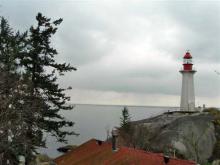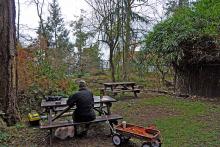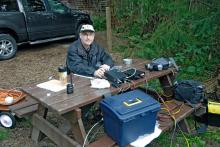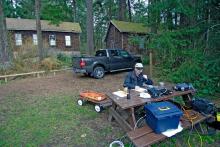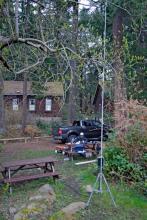Activating Point Atkinson Lighthouse
Activating Point Atkinson Lighthouse
It was the last Saturday, March 30, 2008, of the Spring Lites QSO Party sponsored by the Amateur Radio Lighthouse Society and therefore our last chance to participate in the contest for this year. So despite the questionable weather, club members Ralph (VE7OM) and Eric (VE7EGK) packed up their portable gear set out for Lighthouse Park in West Vancouver.
We arrived in West Vancouver around 10AM and immediately stopped at the small mall above the park to purchase a few necessary supplies to provide on-going sustenance during the grueling operating period soon to start. Of course a quick stop to the local Starbucks was the essential final stop prior to entering the park.
As we were not renting the facility, we did not have vehicle access beyond the main parking lot. So we carefully searched out a location close to the end of the lot to minimize the distance we would need to carry our equipment. Once a suitable location was selected we unloaded our cases into a small red wagon that Ralph had brought to help in transport. As the weather was currently dry and there being only two of us we elected to leave our day tent in the car in order to keep things to a single trip – little did we know that this would later bite us.
Once the wagon was loaded up we hiked out to the point dragging the wagon behind us. The road was rough and steep in places making the task a bit tiring but we got to the point after around 15 minutes. There I met another ham, William (VE7WKG) who was teaching a first aid course in the park. He was expecting us and gave us access to a power plug in the building he was using. We chose the site that Eric had spotted on his earlier visit to the park and soon we were busy assembling the radio equipment. We placed the home built vertical antenna, that had been built from the salvaged parts from the beam Ralph once had on his roof before the wind removed it earlier this year, between our operating position and the water. The radio was placed on a nice large park table which gave us lots of room to spread out.
So once it was all assembled and the power was ready and we flipped the switch to start our first QSO. We immediately heard our first call sign and immediately thought we had a serious technical malfunction. Coming through the small speaker of the IC-706G II was the very familiar voice of Stuart (VA7CRH). Stuart, one of our club members who couldn’t join us today as he was busy with non-radio tasks! Needless to say we had a quick chat with him on the HF band. He reported that our signal was very weak and so we continued chatting with him via the local 2m repeater using Eric’s Handheld. Such a weak signal report was not an encouraging start to our activation.
We continued to work the 20m band and soon had a second contact, VA7OO, another operator only a few miles away. Third on the log was NH6P in Hawaii followed by a few California stations and then WY3P in Maryland and KL5O in Alaska. We were hearing many stations working the CQ WX Contest and quickly knew that the antenna was working better for distance than local. The pile-ups were deep and though we heard fairly well, being heard was much harder. This was particularly true to the east as we had a small rock face not too far from the antenna.
As the day progressed the clouds advanced and soon it was drizzling and then raining harder on us. We were able to slide down the park table to the end closest to a large fir tree which protected us from the rain a fair amount, but it had gotten quite damp and cold. After about 45 minutes the rain passed and we were able to do some more calling. The afternoon had fewer contacts as the band conditions had worsened though we did reach V73PX in the Marshal Islands. At 2PM we packed up and organized our wagon for the mainly uphill hike back to the car. It was a tiring return walk but we got back before any more showers hit and were able to rest in the car on the drive home. During our return we listened in on an IRLP QSO using the local UBC repeater and one in England. It was a fun adventure and proved out our portable system in preparation for Field Day in June. We hope to do another field exercise in May with this same equipment.

